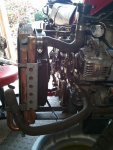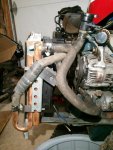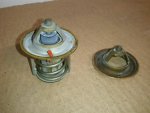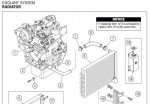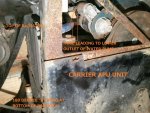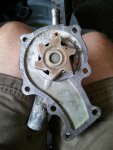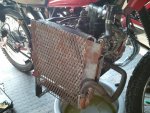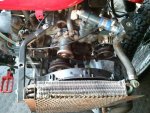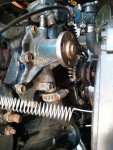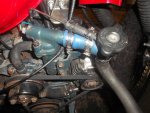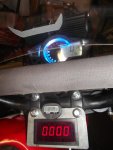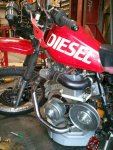Hello all, I have been on this site as well as Dieselbike.net for many, many hours gaining inspiration for my first diesel motorcycle build. It is a 200cc enduro now powered by a Kubota Z482 from a Carrier APU unit. I will most certainly post info and photos of the entire build process but first I hope that you all might assist me with 2 problems, overheating and the cvt. First off, my bike overheats very quickly. The top radiator hose nearest the thermostat housing reaches 240 F while the lower hose remains at ambient temperature. I have forced water both directions through the radiator and the engine at thermostat housing/water pump mounting cavity: Neither are clogged. As far as the water pump itself, I am only aware of 3 failure modes: 1. leaking weephole. 2. bad bearings. 3. impeller broken from or freewheeling on belt driven shaft. I have determined none of these are the case. The Carrier APU unit this came from actually had the radiator mounted approximately 10" lower in relation to the engine that what you see I have mounted to the right side of the bike where my radiator is nearly flush to the valve cover. The top of the radiator on the APU leads directly into the lower hose coming off the water pump. The lower hose off the radiator connects to a 180 degree copper u bend and then up around and back to the top thermostat housing. This routing (which has been confirmed correct by a Carrier service manual) makes absolutely no sense to me as every radiator I have ever seen has its uppermost top hose leading directly to the thermostat that when reaches operating temperature allows the hot fluid to flow from the motor downwards through the cooling passages and back up to the pump to complete the circuit. I have routed my hoses in both configurations with the same results: severe and immediate overheating. I am using 50/50 premix coolant. The spare thermostat I have starts to open at 160 degrees F. The faulty thermostat has been cut in half and only the "shell" is being used at the moment. I would expect this shell to delay the heating of the engine until ultimately both radiator hoses and the radiator itself reach 230 F at which point I am overheating. Does the system need to be "burped"? If so, how is that done quickly? I should mention I am using a Kawasaki Ninja 250 radiator cap and hose elbow which obviously is mounted at the absolute highest point. If any of you would provide some insight into what I am missing I would appreciate it immensely!!! Thank you all, I love this website!
Attachments
-
90.8 KB Views: 592
-
88.9 KB Views: 592
-
87 KB Views: 635
-
20.2 KB Views: 1,435
-
96.7 KB Views: 523


